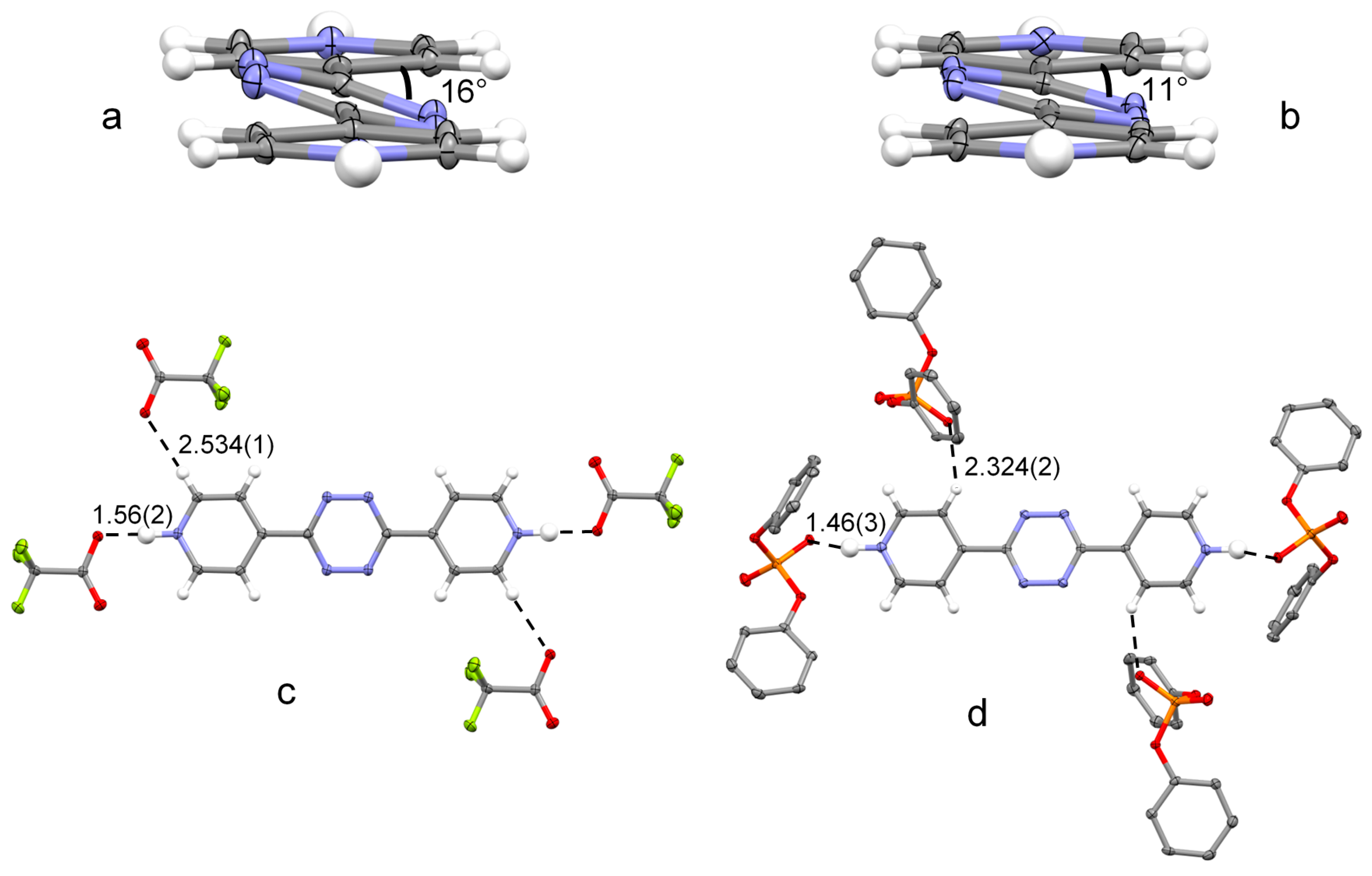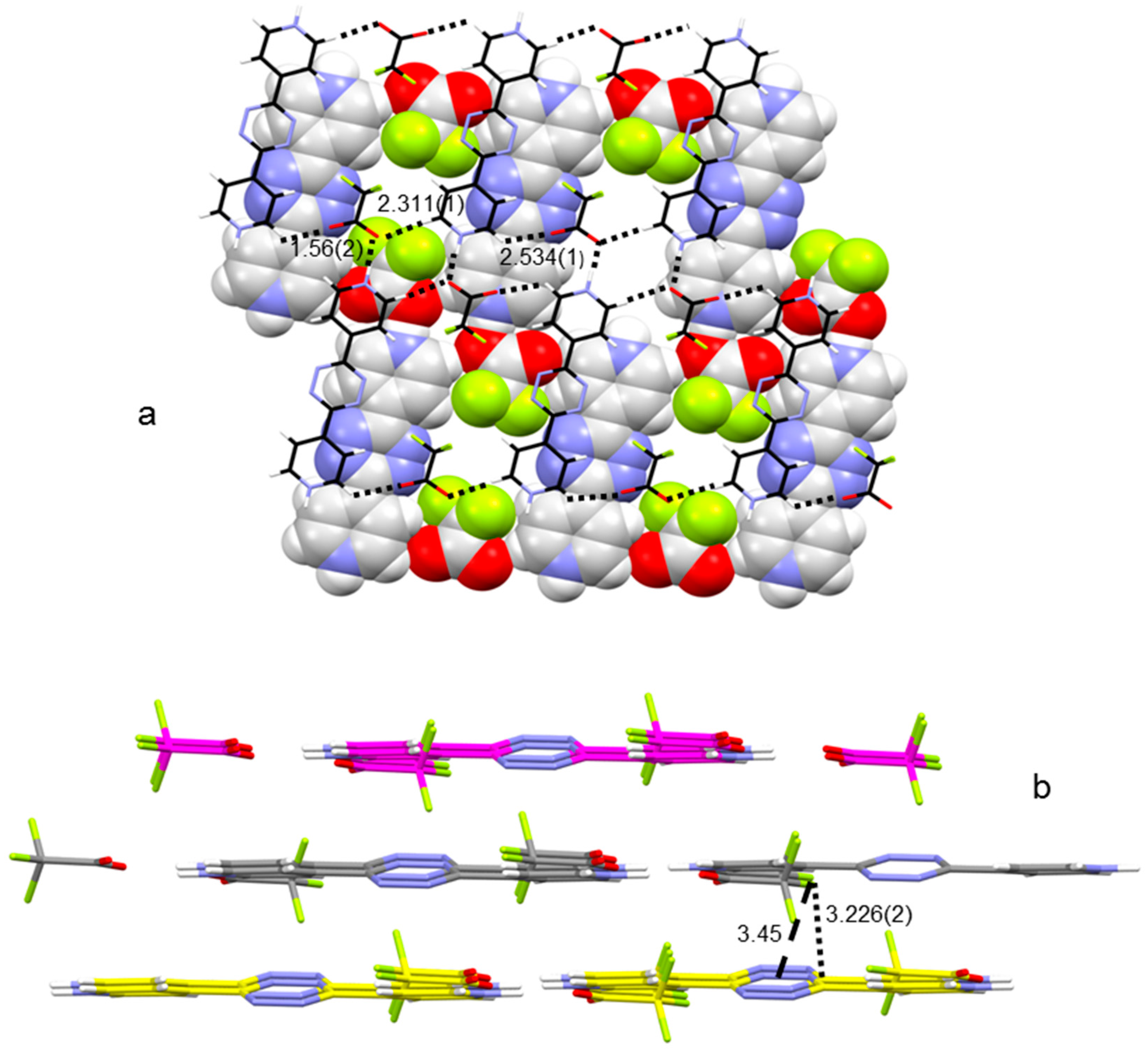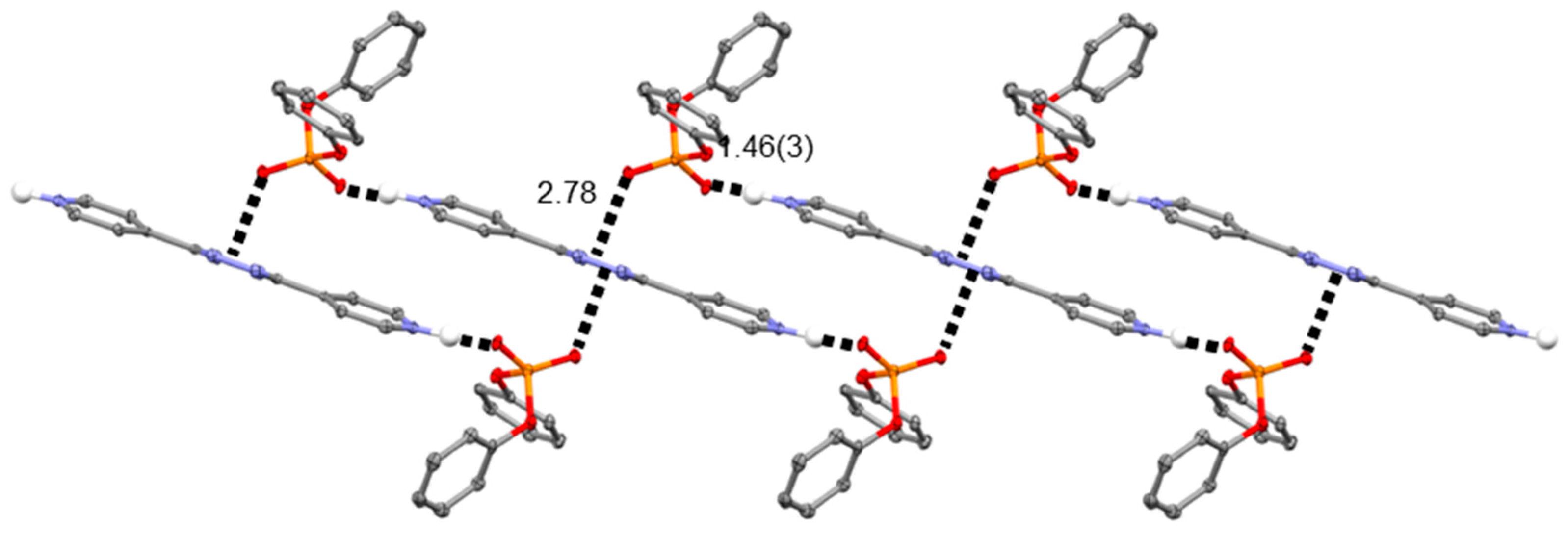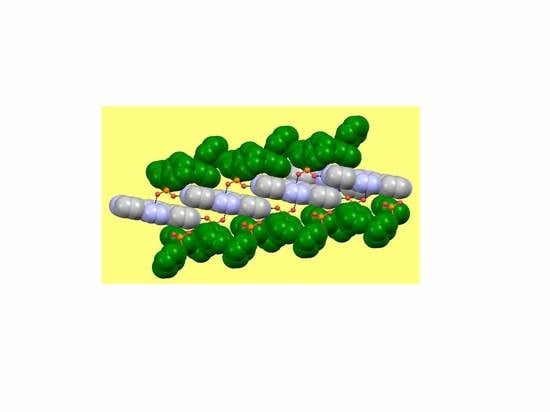Network Formation via Anion Coordination: Crystal Structures Based on the Interplay of Non-Covalent Interactions
Abstract
:1. Introduction
2. Results and Discussion
Crystal Structures of H2L(CF3CO2)2 and H2L(Ph2PO4)2
3. Materials and Methods
3.1. General
3.2. Crystal Structure Determination
4. Conclusions
Supplementary Materials
Acknowledgments
Author Contributions
Conflicts of Interest
References
- Steed, J.W.; Atwood, J.L. Supramolecular Chemistry, 2nd ed.; John Wiley & Sons: Chichester, UK, 2009. [Google Scholar]
- Quiñonero, D.; Frontera, A.; Deyà, P.M. Anion–π Interactions in Molecular Recognition. In Anion Coordination Chemistry; Bowman-James, K., Bianchi, A., García-España, E., Eds.; Wiley-VCH: Weinheim, Germany, 2012; pp. 321–361. [Google Scholar]
- Molina, P.; Zapata, F.; Caballero, A. Anion recognition strategies based on combined noncovalent interactions. Chem. Rev. 2017, 117, 9907–9972. [Google Scholar] [CrossRef] [PubMed]
- Rissanen, K. Crystallography of encapsulated molecules. Chem. Soc. Rev. 2017, 46, 2638–2648. [Google Scholar] [CrossRef] [PubMed]
- Lucas, X.; Bauzá, A.; Frontera, A.; Quiñonero, D. A Thorough anion–π interaction study in biomolecules: On the importance of cooperativity effects. Chem. Sci. 2016, 7, 1038–1050. [Google Scholar] [CrossRef]
- Chifotides, H.T.; Dunbar, K.R. Anion–π interactions in supramolecular architectures. Acc. Chem. Res. 2013, 46, 894–906. [Google Scholar] [CrossRef] [PubMed]
- Ballester, P. Experimental quantification of anion–π interactions in solution using neutral host–guest model systems. Acc. Chem. Res. 2013, 46, 874–884. [Google Scholar] [CrossRef] [PubMed]
- Watt, M.M.; Collins, M.S.; Johnson, D.W. Ion–π interactions in ligand design for anions and main group cations. Acc. Chem. Res. 2013, 46, 955–966. [Google Scholar] [CrossRef] [PubMed]
- Arranz-Mascarós, P.; Bazzicalupi, C.; Bianchi, A.; Giorgi, C.; Godino-Salido, M.L.; Gutierrez-Valero, M.D.; Lopez-Garzón, R.; Savastano, M. Thermodynamics of anion–π interactions in aqueous solution. J. Am. Chem. Soc. 2013, 135, 102–105. [Google Scholar] [CrossRef] [PubMed]
- Savastano, M.; Arranz-Mascarós, P.; Bazzicalupi, C.; Bianchi, A.; Giorgi, C.; Godino-Salido, M.L.; Gutiérrez-Valero, M.D.; López-Garzón, R. Binding and removal of octahedral, tetrahedral, square planar and linear anions in water by means of activated carbon functionalized with a pyrimidine-based anion receptor. RSC Adv. 2014, 4, 58505–58513. [Google Scholar] [CrossRef]
- Schottel, B.L.; Chifotides, H.T.; Shatruk, M.; Chouai, A.; Pérez, L.M.; Bacsa, J.; Dunbar, K.R. Anion–π interactions as controlling elements in self-assembly reactions of Ag(I) complexes with π-acidic aromatic rings. J. Am. Chem. Soc. 2006, 128, 5895–5912. [Google Scholar] [CrossRef] [PubMed]
- Savastano, M.; García-Gallarín, C.; Giorgi, C.; López de la Torre, M.D.; Pichierri, F.; Bazzicalupi, C.; Bianchi, A.; Melguizo, M. Halide and hydroxide anions binding in water. Dalton Trans. 2018. [Google Scholar] [CrossRef] [PubMed]
- Savastano, M.; García, C.; López de la Torre, M.D.; Pichierri, F.; Bazzicalupi, C.; Bianchi, A.; Melguizo, M. Interplay between salt bridge, hydrogen bond and anion–π interactions in thiocyanate binding. Inorg. Chim. Acta 2018, 470, 133–138. [Google Scholar] [CrossRef]
- Savastano, M.; Bazzicalupi, C.; García, C.; López de la Torre, M.D.; Mariani, P.; Pichierri, F.; Bianchi, A.; Melguizo, M. Iodide and triiodide anion complexes involving anion–π interactions with a tetrazine-based receptor. Dalton Trans. 2017, 46, 4518–4529. [Google Scholar] [CrossRef] [PubMed]
- Savastano, M.; Bazzicalupi, C.; García, C.; López de la Torre, M.D.; Pichierri, F.; Bianchi, A.; Melguizo, M. Anion complexes with tetrazine-based ligands: Formation of strong anion–π interactions in solution and in the solid state. Inorg. Chem. 2016, 55, 8013–8024. [Google Scholar] [CrossRef] [PubMed]
- Savastano, M.; Bazzicalupi, C.; García, C.; López de la Torre, M.D.; Bianchi, A.; Melguizo, M. Supramolecular forces and their interplay in stabilizing complexes of organic anions: Tuning binding selectivity in water. Manuscript in preparation.
- Razavi, S.A.A.; Masoomi, M.Y.; Morsali, A. Double solvent sensing method for improving sensitivity and accuracy of Hg(II) detection based on different signal transduction of a tetrazine-functionalized pillared metal−organic framework. Inorg. Chem. 2017, 56, 9646–9652. [Google Scholar] [CrossRef] [PubMed]
- Bezuidenhout, C.X.; Esterhuysen, C.; Barbour, L.J. Solvatochromism as a probe to observe the solvent exchange process in a 1-D porous coordination polymer with 1-D solvent accessible channels. Chem. Commun. 2017, 53, 5618. [Google Scholar] [CrossRef] [PubMed]
- Dooris, E.; McAnally, C.A.; Cussen, E.J.; Kennedy, A.R.; Fletcher, A.J. A Family of nitrogen-enriched metal organic frameworks with CCS potential. Crystals 2016, 6, 14. [Google Scholar] [CrossRef] [Green Version]
- Pal, T.K.; Neogi, S.; Bharadwaj, P.K. Versatile tailoring of paddle-wheel ZnII metal–organic frameworks through single-crystal-to-single-crystal transformations. Chem. Eur. J. 2015, 21, 16083–16090. [Google Scholar] [CrossRef] [PubMed]
- Sen, S.; Neogi, S.; Aijaz, A.; Xu, Q.; Bharadwaj, P.K. Structural variation in Zn(II) coordination polymers built with a semi-rigid tetracarboxylate and different pyridine linkers: Synthesis and selective CO2 adsorption studies. Dalton Trans. 2014, 43, 6100–6107. [Google Scholar] [CrossRef] [PubMed]
- Kalita, A.C.; Gogoi, N.; Jangir, R.; Kuppuswamy, S.; Walawalkar, M.G.; Murugavel, R. Ab initio chemical synthesis of designer metal phosphate frameworks at ambient conditions. Inorg. Chem. 2014, 53, 8959–8969. [Google Scholar] [CrossRef] [PubMed]
- Lu, Z.-Z.; Zhang, R.; Li, Y.-Z.; Guo, Z.-J.; Zheng, H.-G. Solvatochromic behavior of a nanotubular metal–organic framework for sensing small molecules. J. Am. Chem. Soc. 2011, 133, 4172–4174. [Google Scholar] [CrossRef] [PubMed]
- Withersby, M.A.; Blake, A.J.; Champness, N.R.; Hubberstey, P.; Li, W.-S.; Schröder, M. Anion control in bipyridylsilver(I) networks: A helical polymeric array. Angew. Chem. Int. Ed. 1997, 36, 2327–2329. [Google Scholar] [CrossRef]
- Liu, K.; Han, X.; Zou, Y.; Peng, Y.; Li, G.; Shi, Z.; Feng, S. Solvothermal synthesis, structures, and gas adsorption properties of two cadmium-organic frameworks. Inorg. Chem. Commun. 2014, 39, 131–134. [Google Scholar] [CrossRef]
- Li, J.; Jia, D.; Meng, S.; Zhang, J.; Cifuentes, M.P.; Humphrey, M.G.; Zhang, C. Tetrazine chromophore-based metal–organic frameworks with unusual configurations: Synthetic, structural, theoretical, fluorescent, and nonlinear optical studies. Chem. Eur. J. 2015, 21, 7914–7926. [Google Scholar] [CrossRef] [PubMed]
- Fernández, B.; Seco, J.M.; Cepeda, J.; Calahorro, A.J.; Rodríguez-Diéguez, A. Tuning the porosity through interpenetration of azobenzene-4,4′-dicarboxylate-based metal–organic frameworks. CrystEngComm 2015, 17, 7636–7645. [Google Scholar] [CrossRef]
- Maekawa, M.; Sugimoto, K.; Okubo, T.; Kuroda-Sowa, T.; Munakata, M. Dinuclear and polymeric copper(I) ethylene adducts bridged by bis-pyridyl derivatives of 1,2,4-triazole and 1,2,4,5-tetrazine. Inorg. Chim. Acta 2015, 426, 64–70. [Google Scholar] [CrossRef]
- Hsu, C.-J.; Tang, S.-W.; Wang, J.-S.; Wang, W.-J. Self-assembly molecular complex by 3,6-di(pyridin-4-yl)-1,2,4,5-tetrazine with trimesic acid through H-bonding. Mol. Cryst. Liq. Cryst. 2006, 456, 201–208. [Google Scholar] [CrossRef]
- Chainok, K.; Neville, S.M.; Forsyth, C.M.; Gee, W.J.; Murray, K.S.; Batten, S.R. Supramolecular architecture of silver(I) coordination polymers containing polydentate N-donor ligands. CrystEngComm 2012, 14, 3717–3726. [Google Scholar] [CrossRef]
- Liu, H.; Du, M.; Bu, X.-H. 3,6-Di-2-pyridinio-1,2,4,5-tetrazine diperchlorate. Acta Cryst. 2001, E57, o127–o128. [Google Scholar] [CrossRef]
- Dey, S.K.; Saha, R.; Biswas, S.; Layek, A.; Middya, S.; Steele, I.M.; Fleck, M.; Ray, P.P.; Kumar, S. Tetrabromoterepthalic acid in designing co-crystals and salts: Modification of optical properties and schottky barrier effect. Cryst. Growth Des. 2014, 14, 207–221. [Google Scholar] [CrossRef]
- Sheldrick, G.M. Crystal structure refinement with SHELXL. Acta Cryst. 2015, C71, 3–8. [Google Scholar]
- Mateus, P.; Bernier, N.; Delgado, R. Recognition of anions by polyammonium macrocyclic and cryptand receptors: Influence of the dimensionality on the binding behavior. Coord. Chem. Rev. 2010, 254, 1726–1747. [Google Scholar] [CrossRef]
- Bowman-James, K. Alfred Werner revisited: The coordination chemistry of anions. Acc. Chem. Res. 2005, 38, 671–678. [Google Scholar] [CrossRef] [PubMed]
- García-España, E.; Díaz, P.; Llinares, J.M.; Bianchi, A. Anion coordination chemistry in aqueous solution of polyammonium receptors. Coord. Chem. Rev. 2006, 250, 2952–2986. [Google Scholar] [CrossRef]
- Bianchi, A.; Micheloni, M.; Paoletti, P. Supramolecular Interaction between Adenosine 5′-Triphosphate (ATP) and polycharged tetraazamacrocycles. Thermodynamic and 31P NMR studies. Inorg. Chim. Acta 1988, 151, 269–272. [Google Scholar] [CrossRef]
- Bencini, A.; Bianchi, A.; Giorgi, C.; Paoletti, P.; Valtancoli, B.; Fusi, V.; García-España, E.; Llinares, J.M.; Ramírez, J.A. Effect of nitrogen methylation on cation and anion coordination by hexa- and heptaazamacrocycles. Catalytic properties of these ligands in ATP dephosphorylation. Inorg. Chem. 1996, 35, 1114–1120. [Google Scholar] [CrossRef] [PubMed]
Sample Availability: Samples of the compounds are not available from the authors |





© 2018 by the authors. Licensee MDPI, Basel, Switzerland. This article is an open access article distributed under the terms and conditions of the Creative Commons Attribution (CC BY) license (http://creativecommons.org/licenses/by/4.0/).
Share and Cite
Savastano, M.; Bazzicalupi, C.; Mariani, P.; Bianchi, A. Network Formation via Anion Coordination: Crystal Structures Based on the Interplay of Non-Covalent Interactions. Molecules 2018, 23, 572. https://doi.org/10.3390/molecules23030572
Savastano M, Bazzicalupi C, Mariani P, Bianchi A. Network Formation via Anion Coordination: Crystal Structures Based on the Interplay of Non-Covalent Interactions. Molecules. 2018; 23(3):572. https://doi.org/10.3390/molecules23030572
Chicago/Turabian StyleSavastano, Matteo, Carla Bazzicalupi, Palma Mariani, and Antonio Bianchi. 2018. "Network Formation via Anion Coordination: Crystal Structures Based on the Interplay of Non-Covalent Interactions" Molecules 23, no. 3: 572. https://doi.org/10.3390/molecules23030572





